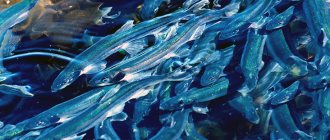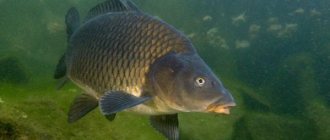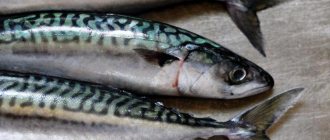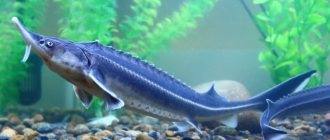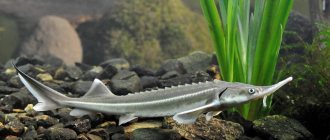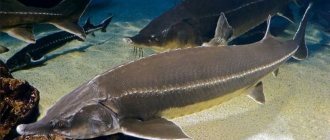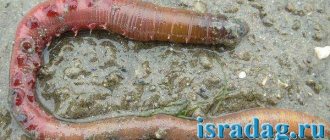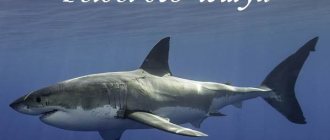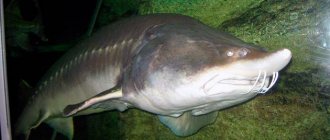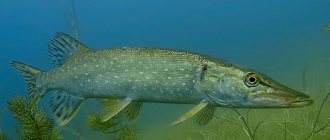Three-year turnover of fish in your pond
The epic began in 1995.
My wife and I bought a house with a plot of 15 acres in the Tver region. First under the dacha. And after that I didn’t want to leave and stayed to live - to live, to make good all year round, until now.
We dug a small pond on the site, which we don’t regret at all, and this year our pond turned 25 years old
The pond, by the standards of the site, is large, 12 by 25 m, for swimming like in a pool. A year later I stocked crucian carp. and the “soul went to heaven”
Koi carp, common carp, sturgeon, bester, oster, sterlet, black and white carp, smallmouth and largemouth carp, bleak, roach, topfin, perch, etc. Kolandike in short!
After 5 years, I got tired of “cracking around” and abandoned this business, I thought - it’s not profitable!
By this time
I have already “stumbled” into fish farming, having read 50 thousand pages from vocational technical to high school, conducted successful experiments, discovered something new that is not in textbooks.
Between his main work, he began stocking large reservoirs with fish for his friends, treating fish and providing consultations. Everything happens along the way, without any “strain”.
This gave me great pleasure, because when you understand what you are doing it is already very interesting.
I actually love cleaning fish.
I don’t know many people who like to clean, but I seize the moment, unless of course there is a lot of it. I look at what I ate and drank, and look for parasites.
In general, I clean it conscientiously until I’m completely dead, because the taste of a dead one is strikingly different from that of a living one.
Who doesn’t know, fish, like any edible animal, must be drained of blood, otherwise it becomes bitter and spoils faster
After years
The pond is idle and I don’t particularly go swimming. Something needs to be decided.
And I decided! Decided !
I pulled myself together and counted all the costs. Now you need to think about how to profitably compensate for the money spent, and this is for its digging, equipment and maintenance.
In general, poor is poor, but you can provide your small family with fish. In addition, you can get free fertilizer from the bottom in the form of sludge for your garden and vegetation for the chickens, which is eaten by “Mama Don’t Cry”
And a festive smile appeared on my face.
I decided to do a 3-year fish turnover
To catch a large one every year and leave the small ones for growing. Of course there is pike in my pond
and carp will not grow as quickly as in large reservoirs, but still..
I choose pike and carp
They grow quickly, require little oxygen, and are not picky about nutrition. I’ve been growing this for several years now, so I can share my practical knowledge, and not from books like “Sobaneev” or “Sabaneev”
Video “catching pike in your pond” at the end of the article
It feeds all year round on small and large fish, including its own relatives. Frogs, living organisms with a high protein content, such as amphipods.
If there is a lack of living food supply, it still survives, but unfortunately does not grow.
Of course, if you don’t feed, where will the weight gain come from?
I talked about pike in more detail in the article “Pike in the Pond”
It feeds on high-protein organisms in the depths and at the bottom of the reservoir. It grows quickly with decent feeding and moderate “planting”, i.e. stocking with fish in a reservoir. It is more demanding of oxygen than pike.
I talked in more detail in the article “Carp in the Pond.”
How many fish do I put in the pond?
I stock the pike that I bring back from fishing, but weighing no more than 1 kg. The total weight of pike in the pond is about 15 -20 kg
If there are no carp in the pond at all, then I add 25 pieces at once, once every 3 years, weighing 300-500 grams, with a reserve in case a large pike does eat some of them.
In general, every year you need to add 300-500 grams of fish. carp, according to the annual catch... But it doesn’t always work out.
How do fish grow in my pond?
- For the first year, pike in my pond with 200 gr. grows up to 1.3 kg. Carp from 300 grams grows to 1 kg
- In the 2nd year, the pike is already more than 2 kg. Carp 1.5 kg and larger
- 3rd year pike 3 kg. and more. Carp 2 kg and larger
In order for the pike to grow, I introduce live food that spawns several times a year: crucian carp, perch, and topwater. Perch and topwater do not muddy the water, which is “gut”
The pike eats quickly and you have to launch more and more. But there is always some fish in the freezer and there are no interruptions all year round.
Yes, I agree the pond is not small and the area allows it, but without a head and not here and there...
Well, that's how it is, friends. What can I say...
Read the comments, there are a lot of interesting things there!
Friends ! Your comments and likes are new publications.
Types of baits and lures for silver carp
Choosing gear is only half the battle. The choice of bait and bait for catching silver carp is of no small importance.
Technoplankton, which has been sold in stores since recent times, is used as bait. It is considered an effective bait for catching silver carp. They are made in the form of barrels with different additives and flavors. Sinking into the water, technoplankton swells and creates a cloud of turbidity around itself, attracting fish, which smell it, come closer and thus get hooked.
It’s a good idea to use bait of plant origin, namely pieces of bread, crumpled into balls with the addition of various oils. However, excessive consumption of oils is not recommended, as it will lead to the opposite effect - it will scare away all the fish.
If we consider baits, then the most preferable are self-prepared porridges with the addition of crumbled cookies or vanilla sugar. But if you don’t have enough time to prepare porridge, ready-made baits are available for sale. For example, a geyser, which, when immersed in water, releases bubbles and also creates a cloud of turbidity that attracts fish.
For effective winter fishing, it is recommended to make so-called bouquets, consisting of dried small branches with the addition of herbs: mint, nettle, hemp. A weight is attached to the bottom of the bouquet and lowered into a hole at the bottom of the reservoir. It is advisable to additionally feed this place, then there is a chance of a good catch, since fish are attracted to such bushes,
And finally, the fisherman should not forget about the rules of successful fishing. Namely, choose the right places for fishing, prepare gear in advance and stock up on all the equipment just in case, prepare bait and lures. When fishing, do not make sudden jerks so as not to miss the fish.
Silver carp fishing is in great demand among fishermen, as it is not a small fish. You can prepare various culinary dishes from caught silver carp. Despite its fat content, the fish is good when stewed, salted, fried, baked in the oven, and also prepared using hot and cold smoking.
Happy fishing everyone!
Source: fishelovka.com
Breeding and propagation of silver carp
Silver carp, the desired trophy of any fisherman, this fish comes from the rivers of the Amur basin, is not found on the territory of Ukraine, it is bred artificially, therefore breeding this fish is a very profitable and profitable business, not only in terms of sales, but also as a bait for fishermen for your paid reservoirs. Breeding silver carp in a pond is not a tricky business, but it is labor-intensive.
Silver carp is characterized by rapid growth and weight gain; large individuals reach 20-30 kg in weight and a length of up to 1 meter. Such fish have no enemies in reservoirs, so they reproduce quickly. It belongs to the type of carp and most often silver carp are bred together with carp and grass carp. This type of fish dominates in the field of industrial fish farming and farming. And not in vain, because its presence can double the fish productivity of any fishery.
Types of silver carp
When asking the question: “What does silver carp eat?”, you should understand one important thing. The whole truth is that there are several types of these creatures, and each of them has its own food preferences. In particular, the following individuals live in the CIS.
- Silver carp is a medium-sized fish with lighter scales than its close relatives.
- Bighead carp is a larger species of fish, having a huge head, weighing about 40-50% of the total mass of the silver carp.
- Hybrid silver carp is a product of breeders that has absorbed all the advantages of previous species.
Breeding silver carp in a pond
There are three main types of silver carp: white (or common) silver carp; bighead carp; hybrid silver carp.
Next, we will look at each of these types separately in more detail:
Silver carp - lives in a school, is of medium size, the head makes up about twenty percent of the total mass.
The bighead carp is larger, but the head makes up half of its total mass, the color is darker than the usual silver carp, the main advantages of this species are a more extensive diet and the fastest weight gain.
Hybrid silver carp - Has absorbed the best of the two species, retaining the relatively small head size of the first and receiving a rapid weight gain (slightly lower than that of the bighead) from the second, it has also become more cold-resistant.
What to feed silver carp
Silver carp feeds on algae and phytoplankton; bighead carp eats zooplankton, so it gains weight faster; the hybrid species feeds on both phytoplankton and zooplankton.
In terms of diet, silver carp gets along very well with grass carp, they complement each other perfectly, but bighead carp competes with carp, keep this fact in mind. Silver carp also consume artificial food.
Temperature conditions and habitats:
These fish are very thermophilic; they love warm water, heated up to 25 degrees. In such conditions, maximum weight gain occurs. Reservoirs with a muddy bottom and a depth of up to 4 meters are best suited for their life. In the morning and evening, silver carp approach the shore and during the day they move further away from it.
Reproduction of silver carp:
It reaches the ability to reproduce at the age of three to five years. Spawning occurs in early summer, when the water temperature warms up to 20°C. Silver carp acquires marketable appearance after two years. The caviar is floating. Spawns on the current in places with whirlpools.
Silver carp has a high meat value, it is very tender and has excellent taste; it is consumed both fresh and frozen.
Breeding fish at home
Breeding silver carp can become a profitable business if everything is calculated correctly and correctly, we hope our article helped you. With this we say goodbye to you, we wish you good luck in breeding silver carp, until we meet again!
Valuable food product
The energy value of 100 grams of raw silver carp is 86 Kcal. Depending on the cooking method, age and size of the fish, this figure changes. For example, when stewing, calorie content drops by 10 kcal, and when frying, it rises by 15.
Fish meat over 5 years old is considered fattier and therefore has a higher energy value. At the same time, silver carp meat is rich in proteins and carbohydrates that are useful for digestion, which are easily absorbed by the body. In addition, it is rich in omega-3 and omega-6 acids, vitamins B, E and D, provitamin A, and contains large quantities of phosphorus, iron, sodium, potassium, calcium, zinc and sulfur.
Omega-3 and omega-6 acids, when consumed regularly, prevent the formation of malignant tumors, nervous disorders, the development of cardiovascular failure, hypertension, and reduce cholesterol levels to normal levels. A huge amount of minerals can improve the growth of nails, hair, nails, promotes reparative regeneration, in particular of the skin, stimulates the production of iron-containing hemoglobin, which performs a gas exchange function and removes toxic substances.
Patients with hypertension, diabetes, and gout are recommended to eat silver carp meat. A diet containing large amounts of silver carp meat has a positive effect on the body.
For diseases such as diabetes, hypertension, gout, gastritis, or low acidity, it is also recommended to eat boiled, steamed, or stewed silver carp. Reductions in sugar, cholesterol and blood pressure are observed within a few weeks.
Silver carp breeding
Breeding silver carp in a pond: reproduction, nutrition.
Silver carp is a large freshwater fish of the carp family.
It is represented by three types: ordinary (or white), variegated and hybrid.
- In natural conditions, the common silver carp reaches a length of 1 m and a weight of 15-17 kg.
- The bighead carp differs from the white carp in its darker color, rapid growth and varied diet.
- Hybrids are characterized by better linear and weight growth indicators, increased vitality and productivity.
Silver carp can be grown together with grass carp and carp. This type of fish grows quite quickly.
Feeding bighead carp

Drawing of bighead carp
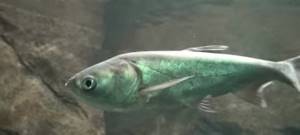
Photo of bighead carp, or southern silver carp (lat. Hypophthalmichthys nobilis)
Growing bigheaded carp in fish polyculture allows one to obtain additional products, especially in those conditions when a powerful zooplankton food base is created and carp, due to its biological properties, is not able to use it, since in the second year of life it uses benthos more. The motley silver carp fish, like the white silver carp, grows well in the southern zones; in the northern zone it can reach a marketable weight of 450-500 grams by autumn, provided that it is stocked with at least 50 grams of planting material. If there is a lack of natural food resources, it switches to actively searching for and eating food in feeding areas, so stocking density should be treated more carefully, especially since the utilization of nutrients from food prepared according to recipes for carp is used by bighead carp with less effect than by the carp itself .
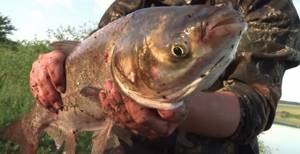
Photo of silver carp caught on technoplankton
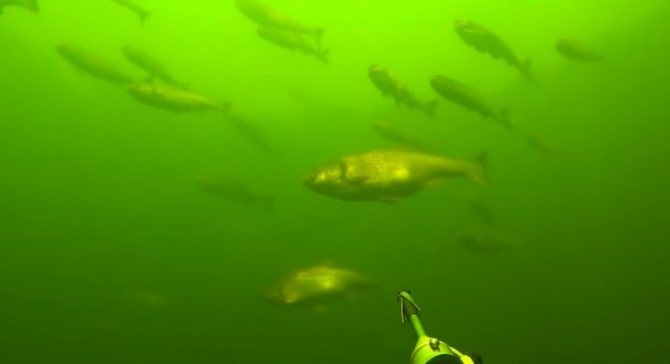
In the photo, underwater hunting for silver carp
Silver carp nutrition
Silver carps are a heat-loving fish species; they feel good in warm water up to +250C. During the warm period, they have an excellent appetite; with the onset of cold weather, the fish practically stop feeding.
To live, silver carp choose areas with soft vegetation and a muddy bottom. The depth in these places does not exceed 3.5 meters.
They rarely rise to the surface, only at sunset and dawn they swim closer to the shore, and during the day the fish move far from the shore. Fish overwinter in depressions or holes that are located at the bottom of the pond.
The fry of silver carp feeds on zooplankton, and when it grows to 5 cm, it develops a filtering gill apparatus, and the fish switches to phytoplankton and then to detritus.
Silver carp, using its filtering mouthparts, filters green, blooming and cloudy water.
Bighead carp feed not only on phytoplankton and detritus, but also on zooplankton, which is a source of protein and protein. Hybrid silver carp feed on both phytoplankton and zooplankton.
What to feed silver carp
Silver carp. Silver carp breeding
Freshwater and herbivorous fish. The body of the silver carp is moderately high, elongated, slightly convex on top and compressed on the sides, with a wide, developed head. The eyes are set low, their lower edge below the level of the corners of the mouth. The mouth is large, located at the top, the cut is almost vertical. The gill rakers are fused into a continuous ribbon. The fused gill rakers form filter ribbons that resemble an ordinary “sieve” through which water is filtered, and algae are retained and become food for silver carp. The pharyngeal teeth are single-row, very strong, compressed on the chewing surface, striated.
The color is silvery, the back and upper part of the head are greenish-gray, the head is greenish-gray, the sides and belly are silvery. The fins are light gray. The ventral and anal areas are slightly yellowish. The iris of the eyes is silvery. The scales are small, sometimes with a black tint.
Silver carp breeding
The history of breeding fish of the carp family begins in the sixth century AD. The first archaeological finds indicate that conscious fish farming began in the twelfth century. Knowledge about fish breeding has been collected for many centuries in a row and some information is still relevant today. Silver carp is a freshwater herbivorous fish that belongs to the carp family. It is characterized by particularly tasty meat and is produced primarily as fish for consumption. The sale of this fish is seasonal, from September to December. Several years ago, they began to produce and sell silver carp fillets, smoked fish and canned delicious meat.
carp translated from English means silver carp . It has a slightly cone-shaped body, wide and flat, somewhat reminiscent of an airplane. The shape of the head is pointed, there are no mustaches, the mouth opens upward, taking on an almost vertical shape. Small eyes are located below the midline of the head. The spine extends from the gill slits to the beginning of the anal fin. The scales are small. An adult silver carp reaches a length of 100 centimeters and a weight of ten kilograms.
It lives in the warm and deep waters of lakes in China and Russia, mainly in rivers belonging to the Amur River system. Available in Taiwan and Thailand. Thanks to the efforts of scientists, it is widely distributed today in the waters of Central and Eastern Europe.
Fish spawning takes place in the summer, when the water temperature reaches 23-24 degrees. Caviar (500,000 from one female) floats freely in water bodies. After hatching, they live in a quiet bend of the river. In the early stages they feed on zooplankton. In the Yangtze River, silver carp reaches sexual maturity after 3-4 years, in the rivers of Central Europe, in particular in Hungary, at 5-6 years.
Upon reaching a body length of 5-6 cm, phytoplankton begins to dominate in the diet of young silver carp. At the same time, the length of their digestive tract increases and exceeds the body length by six to seven times.
In the former Soviet Union, silver carp hybrids were developed from the joint breeding of spotted silver carp and silver carp. Their hybrids can be found not only in the waters of the CIS countries, but also in Poland, Germany and other Western European countries.
Silver carp meat is very tasty; young fish have a fat content of 8-13%, and adult fish have a fat content of 23%. Meat is valued for its dietary qualities and large amounts of fat-soluble vitamins. It is very tasty hot, smoked and cold.
Silver carp, which is grown in home ponds, refers to the domesticated form of silver carp that lives in the wild. It is resistant to high temperature ranges, withstanding hot summers and very cold winters. Characterized by rapid growth and development. It is not a predatory fish, so different age groups can easily exist side by side.
The fish is not picky about food, prefers natural plant foods, but does not refuse artificial food. Another advantage of fish is winter lethargy and slow breathing, when nutritional needs are reduced to a minimum.
The fish is not very demanding of large amounts of oxygen, can withstand large fluctuations in temperature and acidity of water, and tolerates long journeys and changes in reservoirs.
General characteristics and nutrition of silver carp
White carp (or common) - flattened on the sides, covered with small scales. Two and three year old silver carp are silver in color, while older fish are bluish-gray. The eyes are set deep. The upper back has a dark stripe on both sides, the sides are light. The silver carp's mouth is directed upward. The silver carp has a keel extending from the line of the gill opening to the anal fin. In the Yangtze River (home of the white lobster), fish at the age of 11-15 years reach a weight of 20 kilograms. The intestines of silver carp fish are six times longer than the body. In China, in the Yangtze River, silver carp (white) reaches sexual maturity in three to four years, in Hungary 5-6 years. Spawning of silver carp takes place at temperatures close to 24 degrees.
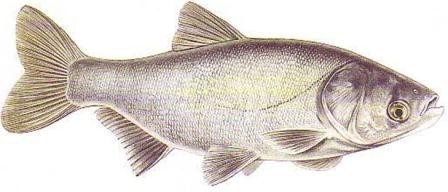
Drawing of a silver carp
For silver carp fry, the first food is zooplankton. When its body length reaches five to ten centimeters, the silver carp switches to feeding on phytoplankton. By this time, the fish develops a filtering apparatus on its gill arches, and the silver carp filters out the phytoplankton. A silver carp weighing a quarter of a kilogram can filter up to 32 liters of water in an hour, while filtering out up to 1300 mg of small algae. Since the food components used are small, the digestion of food in silver carp proceeds quickly - for intensive use of food, the intestines are greatly lengthened. Two-year-old silver carp uses mainly algae, which currently predominate in the reservoir. During intensive feeding, the fish is located in the part of the pond where a mass of algae accumulates under the influence of the wind. With sufficient heat during the second summer, it reaches the marketable weight without much strain. The growth of silver carp is slower than that of grass carp. After the 1st summer it reaches a weight of 25-60 grams (optimally), after the 2nd summer - 300-600 grams, and after the 3rd - 1.0 - 1.6 kilograms. The weight of four-year-old silver carp can be 2.0 – 3.0 kilograms.
The activity of silver carp fish is especially beneficial during the period of “blooming” of water bodies, when algae die off and, settling to the bottom, decompose, creating an oxygen deficiency.
Breeding silver carp in ponds
Silver carp breeding can be organized within two or three years. Depending on what type of system is selected. The size of the pond, its depth, oxygenation, water flow, the fish catching system designed for age categories, the size and stage of development of the fish are taken into account. Separating fish by age category prevents the spread of diseases and creates better sanitary and hygienic conditions for its breeding and growing.
The most common pond size is one that has a surface area of about 150-300 square meters and has the ability to drain water quickly and fill it with water just as quickly.
Spawning ponds are usually filled at the bottom with various types of grass to facilitate egg sticking. Spawning grounds are used in May or June for two weeks.
The first transfer of fish takes place after they have been there for 4-6 weeks, it all depends on the intensity of production. It is allowed to keep up to 800 pieces per hectare of a reservoir of common silver carp, if the annual growth is at least 1.0 kg, and 300 pieces of bighead carp per hectare with an average annual growth of 2.0 kg. The bottom of the reservoir must ensure the implementation of all necessary agricultural procedures. At first, the released fish eat only natural food (flour with winter rye) and therefore there must be the required amount of it.
In the fall, individuals are selected from a school of older fish from which they are expected to produce new offspring next year.
They are placed in a separate pond, in which they overwinter and are kept until spawning begins. Silver carp prefers hot summer sun, water temperature of 25-30 degrees Celsius and a lot of plant food, reservoirs with a muddy river bottom and soft vegetation. The silver carp sees off the sunset and meets the dawn near the coastline; during the day it prefers to be in the middle of the pond, at a depth of 2-3 meters.
Silver carp feeds on phytoplankton, while bighead carp has a more varied diet: detritus and zooplankton, so it grows much faster than white carp, and also loves and eats artificial crumbly food.
Various ways to catch silver carp
The following types of gear for winter fishing for silver carp are distinguished:
- Bottom.
- Float rods.
- Mugs and girders.
Fishing stores and the Internet offer a large selection of winter fishing rods. But many fishermen, based on their practice, make their own fishing rods for their own fishing and for a specific fish.
Bottom fishing rods come with or without a float. The float is a piece of foam plastic, which is attached at a distance of 1-1.5 meters from the lead weights. Then the bait will not be located at the bottom, but a few centimeters from it. Based on the topography of the bottom of the reservoir, it is necessary to select appropriate bottom fishing rods. In deep water starting from the shore, you can use a bottom fishing rod with a short rod. If the depth begins far from the shore, then you will need a longer rod. Also, the length of the donks needs to be selected based on the time of day. As a rule, at night the fish feed close to the shore, so a short rod is suitable.
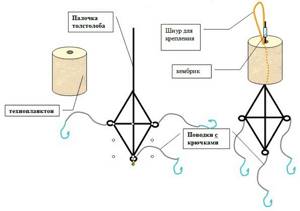
Photo 3. Summer equipment is also suitable for winter fishing.
Float winter fishing rods are perfect for ice fishing for silver carp. They consist of a rod, a fishing line attached to it with a float, which, when immersed in the hole, serves as a bite alarm. Despite the simplicity of the design of such fishing rods, it is necessary to pay attention to the reliability of the fishing rod nod, the reel that is resistant to low temperatures, as well as the material from which the handle is made. All these nuances are important so that winter fishing is hassle-free and brings only pleasure. An angler can set up several of these fishing rods at the same time, using different baits.
You can also use gear such as mugs and girders. There is no fundamental difference between them, only the circle is a free-floating tackle in the hole made, and the girder is installed directly on the hole. The circle consists of a reel attached to a piece of foam with a strong fishing line wound, a sinker and a leash with a hook. When a fish hits the hook, the reel with foam is turned upside down by the signaling device. Thanks to this, the fisherman sees a bite, makes a hook and begins to fish for fish. But the mugs have the following drawback: due to their light weight, if they do not respond to a bite in a timely manner, a large silver carp can drag the tackle under the ice.
Pond fish food

Fishermen are very fond of fish such as crucian carp, and it is undoubtedly a favorite for many. This fish can be found in almost all rivers with a subtropical climate. Therefore, you can seriously think about whether it is possible to grow animals at home, on a pond you made with your own hands. It turns out that crucian carp in a pond at the dacha is a very exciting and profitable business. The first advantage of such an activity is that you can literally go fishing in your pond, and the second is that with the catch we can cook something delicious.
- What kind of reservoir should a body of water be in order to grow fish in it?
- Crucian carp for a home pond (video)
- We also recommend reading
- Feeding fish in a pond
- Fish feeder (video)
- Tips for feeding crucian carp
Show all content
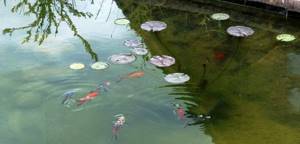
Having built your own personal pond on the site, you can breed crucian carp in it
However, many related questions may arise here. Therefore, in this article we will look step by step at how you can raise pets in a homemade pond, what to feed the fish, and also discuss some practical tips.
Silver carp fishing in winter: the most promising places and times
There are three types of silver carp in the reservoirs of Ukraine: white, hybrid and motley. All of them are distinguished by the presence of a massive head and light color. This fish can reach more than a meter in length and gain weight up to 50 kg. Fishermen value silver carp for its dietary and tender meat.
Silver carp is a very heat-loving fish, and most often in winter it is found in reservoirs with waste water near hydroelectric power stations. In small ponds, representatives of this fish species are found only if there is a sufficient amount of food supply.
For most of the day during the frosty season, the silver carp is in a wintering pit, but when it comes out of it in search of food, it can move throughout the entire water area of the bottom layer of the reservoir.
Fish of this species avoid cold water and areas with strong currents in every possible way. In winter, it is less picky when it comes to food, and feeds mainly on dead organisms of organic origin and pieces of silt.
Silver carp are most active during the first ice and with a thaw. At such times, you should go in search of prey in areas about five meters deep.
Catching silver carp in winter involves casting bait as close to the bottom as possible, at a distance of no more than 15 cm from the silt.
The fish in question bite best in the morning in the winter, around 9-10 o’clock.
What kind of reservoir should a body of water be in order to grow fish in it?
If you already have a reservoir at your dacha - it could be a stream with a dam built on it, or something else, then you are very lucky. For those who don’t have this, you can read the article further, because making your own pond is quite possible.
The suitable dimensions of your pond can be somewhere around 4x6 m, with a depth of 1 to 1.5 m. This is the optimal depth, since the water in such a reservoir will heat up well to a temperature of 25 degrees, which is quite enough for the good development and habitat of small crucian carp, the number of which can reach a couple of dozen with a weight of 250 g.
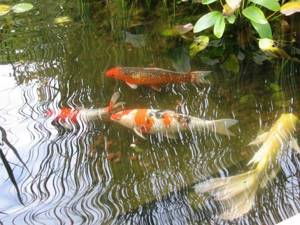
The size of farmed crucian carp is directly proportional to the size of the reservoir itself
Before introducing animals into the pond, it is necessary to adjust the temperature so that it is the same as in the previous reservoir. Otherwise, even a difference of 3 degrees can destroy the fauna.
Crucian carp for a home pond (video)
If you are planning to breed crucian carp, it is important to consider one point - there are two types of it - golden and silver. The second type develops more productively, and its mass is rapidly gaining. Therefore, we recommend farming silver crucian carp.
We also recommend reading
Male silver crucian carp are found quite rarely. Females are the main offspring of crucian carp. However, this does not slow down the spread of the species at all, since neighboring males are quite suitable for this task. To breed crucian carp, it is enough to have females aged 4 years, who have a compressed side and a tall body - they have fairly healthy offspring that develop quickly.
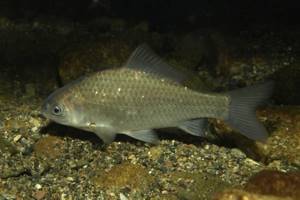
Silver crucian carp is recommended for a home pond
Reproduction and spawning
Sexual maturity in silver carps occurs at 3-5 years of age. The mating period generally occurs in May-June, when the water warms up to 18-20 degrees. During this period, the fish look for a warmer place so that the cold does not damage the eggs.
It should be noted that the fertility of silver carp is very high. Thus, large individuals are capable of producing about 1 million eggs, and small ones - about 500 thousand. At the same time, the female always tries to lay her offspring near the algae so that they cling to them. If the water is well heated, then within a day the first fry will hatch from the eggs. Their length at birth rarely exceeds 5.5 mm.
So, what does a silver carp eat in the wild? It should be noted that this fish begins to eat 4 days after birth. It is during this period that they develop small gills, thanks to which they sift phytoplankton from the water. After the first week, the fish larvae move on to other types of plankton. And only after a month and a half do small silver carps begin to eat adult food.
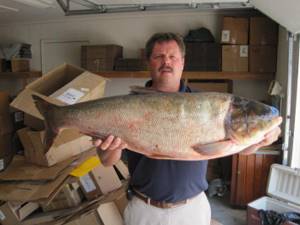
Feeding fish in a pond
In the wild, the food of crucian carp is quite varied. This could be algae and various small animals. Therefore, if you equip a pond for breeding crucian carp, it should have a lot of food. If there is not yet such an amount of food in the pond, the question arises of what to feed the crucian carp.
The process of feeding fish is simple. Worms or some kind of larvae are suitable for this. And digging up or collecting insect larvae in a summer cottage should not cause difficulties. Also, in addition to various larvae, you can steam beans or grains.
For those who do not want to spend all the time on this, you can generally buy prepared food. Compound feed for chickens or some other livestock can easily become fish feed in a pond. Before adding food to the pond, you need to soak the food in water and turn it into dough. You can also buy separate food for crucian carp. It is specially enriched with air so that it does not litter the bottom of the reservoir.

Compound feed is an excellent solution for feeding fish
If the food is in the form of flakes, it must be fed in small portions, otherwise it will settle and spoil the water.
Crucian carp love the following types of food: algae, duckweed, steamed beans, cereals, worms, larvae, bloodworms.
Using bread for feeding is not recommended, as it can spoil the water very quickly.
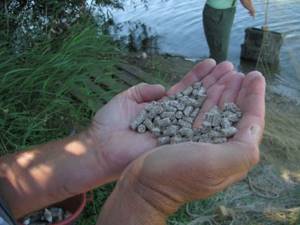
If we talk about the amount of food, it should correspond to the number and weight of crucian carp
It is very easy to overdo it with adding food, so you need to be careful here. The weight of the added food should be 5% of the weight of the crucian carp. It is quite easy to calculate the amount of food - we multiply the number of crucian carp in the reservoir by its average weight.
Example: The weight of one fish is 300 g, the quantity is 40 pcs. Therefore, the mass of all crucian carp is 12 kg. We count 5% of the total mass - 600 g - this will be a single dose of feeding.
Fish feeder (video)
It is advisable to carry out feeding twice a day, at a constant point, at a specific time. In industrial farms, where feeding occurs, bells are installed that signal when feeding. Thus, a reflex is formed in the crucian carp. The advantages of this approach are obvious - the food is well digested by the fish, and the food is fed completely, without littering the bottom.
The amount of food consumed by crucian carp is determined by two factors - weather and temperature. Spring is a time when fish feed quite intensively, unlike summer. In extreme heat, the fish eats little; it mostly finds food on its own. In autumn, the activity of the fish decreases, and when the temperature in the reservoir reaches 10 degrees, they stop feeding it completely.
The type of food eaten by crucian carp changes along with climate and temperature changes. If you have an indoor pond and it is heated, you need to feed the crucian carp all year round.
Fish farming
Today, many fish farms breed silver carp on their farms. Firstly, farmers are attracted by the enormous size of this species, secondly, it gets along well with other inhabitants of ponds, and thirdly, they cope well with the role of orderlies in any body of water.
Besides, what does silver carp eat in nature? That's right, algae and plankton, which means they are quite easy to feed in an artificial environment. After all, a similar diet is found in almost every pond or lake. What is true today is that special feeds designed for increased fish growth are increasingly being used.
As for size, on average a hybrid silver carp after two years of life usually weighs about 600-700 grams. And if you leave it for another year, the weight may double, or even more. So breeding this fish in private reservoirs is considered a very profitable business, especially on an industrial scale.
What do silver carp bite on in winter?
In winter, silver carp can be caught with large dark-colored jigs, and the following can be used as bait:
- Bloodworm.
- Worm.
- Technoplankton, which is freely sold in many fishing stores. It consists mainly of dried phyto and zooplankton, which is the main food of silver carp.
There have been cases when, in winter, silver carp did not disdain to feast on white fish fry, but these cases are rare. There is also an opinion among fishermen that slices of ordinary fresh cucumber can be used as bait.
In winter, for feeding, it is possible to use food for aquarium fish mixed with semolina, as well as small or chopped bloodworms.
How to catch silver carp correctly?
On the Internet you can find a huge number of videos teaching the technique of catching silver carp. First you need to throw bait into the pond. Then place the tackle. In this case, it is imperative to position the float so that the hook is 3-5 cm above the bottom. After all the preparations, all that remains is to wait.
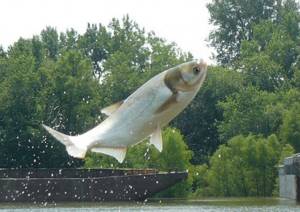
Silver carp jumping out of the water
The rod must be held in your hands, otherwise the silver carp may drag it into the water at the first tug. This fish is quite cautious, so the first bite is similar to a roach bite. As soon as the float is slightly submerged in the water, you can begin to carefully hook the silver carp. After this, you need to put the fishing rod vertically as quickly as possible.
A sharp jerk of the fish will not take long to arrive. And here everything depends on the skill and reaction of the fisherman. If luck smiled and the rod withstood the first tug, you need to place the rod in a horizontal or vertical position, depending on the behavior of the fish. Thus, it can take a long time to exhaust her, but it’s worth it. There is no need to run after baited fish. And even more so, you should not make sudden movements so as not to scare away the silver carp. You need to wait patiently until the fish, tired, begins to pull itself toward the shore without resistance. And you don’t need to let your guard down until the long-awaited catch reaches the shore. After all, at the very last moment, a silver carp can break loose and leave.
Dangerous properties of silver carp
The use of silver carp is contraindicated for people who have severe intolerance to fish and fish products, as well as for those who have allergic reactions to dishes made from silver carp. Particular care should be taken in the case of smoked fish; it must be remembered that hot smoking produces carcinogenic compounds that are dangerous to the body. Therefore, smoked fish (especially hot) is acceptable as an occasional delicacy, but not a permanent product on the menu.
Video
How to choose and store a carcass correctly
If you did not catch silver carp as a trophy catch while fishing, it is important to know how to choose the right fresh fish in a store or market.
The best choice would be a carcass weighing 2-4 kg - it does not have many bones, moderate fat, and the meat is tender. If the choice fell on chilled fish, then you should definitely check its smell. In a fresh carcass, it should resemble the aroma of a river and algae. At the next stage of “inspection” you will have to pay attention to the eyes (should be shiny), gills (pure pink), tail (elastic in a recently caught carcass), scales (shiny, silver). And don’t be afraid to press your finger on the carcass: if it’s fresh, the dent will quickly recover.
Fresh chilled fish carcass cannot be stored in the refrigerator for longer than a day. Marinating will help prolong the freshness of the fish for another 2-3 days. Depending on the smoking method, silver carp will remain edible for 1 to 2 weeks. The most reliable way to store fish for a long time is freezing. A well-cleaned, washed and dried carcass with a paper towel can be stored in the freezer for up to 4 months. But after defrosting, it must be cooked and eaten immediately. Repeated freezing is strictly prohibited.
Equipment for winter fishing for silver carp
The best tackle for winter fishing for silver carp are jigs of lead, black and light green colors. Hooks should be very sharp and durable, number plate 3 or 5.
The best bait for catching silver carp in winter is considered to be a bloodworm.
The rod should be at least 3.5 meters in length. Be sure to equip it with plenty of strong veining. If you want to use a reel, then inertia-free specimens have an undeniable advantage in winter fishing.
The optimal leash for catching silver carp in winter is 70-100 cm long.
We recommend placing the float horizontally when fishing in the frosty season so as not to spook the catch.
When biting, you need to keep the line taut and slowly pull the exhausted prey towards the hole. When fishing, we recommend that you be very careful, since the silver carp bites with a fairly powerful pull, and the downward nod bends instantly. It is better to get the catch out of the hole with a hook.
Fishing for silver carp in winter in Ukraine uses a variety of baits: plant twigs, reed leaves, green or blue foam balls.
And remember, the essence of the main technique for catching silver carp in winter is the ability to carefully “extinguish” the resistance of the fish and skillfully fish it out.
Source: fishportal.com.ua
Silver carp
- a schooling freshwater fish of the carp family, acclimatized in the European part of Russia, reaches enormous sizes and is a desirable trophy for any fisherman, and is also an object of spearfishing. Unlike other large fish species, it feeds on microorganisms and phytoplankton; it is believed that silver carp also feeds on blue-green algae, young shoots of reeds and soft aquatic vegetation. The body of the silver carp is elongated, with small steel-colored scales, the eyes are low-set in relation to the lateral line, the lower jaw noticeably protrudes forward than the upper jaw and is distinguished by its strength, difficult to pierce with a hook.
Bighead carp is also found in nature.
, it is characterized by heterogeneous colors, has a large number of dark spots on the body and is distinguished by a huge mouth in relation to the previous species. There is also a little-known variety - the yellow silver carp, which has a pronounced yellow body color.
There is an opinion that silver carp hibernate
in deep wintering pits and sound sleep, covered with a cocoon of mucus protecting his body from parasites, but this is not so, I personally observed cases of him being caught in the winter using a jig with a bloodworm, although these are rather isolated cases, and the individuals were not distinguished by their outstanding size (up to 2 kg), also in winter, silver carp were shot by underwater hunters in non-frozen areas of reservoirs and it did not stand at the bottom, but moved in the water column. Often, winter fishermen, when catching a predator on a balance beam, took out nets forgotten by poachers and full of rotten fish, most of which were silver carp. All these cases indicate that silver carp still feed in winter and move around the water area, although much less actively than in summer, but still.
All types of silver carp
They are distinguished by a large mouth and lack of teeth, which is determined by their peculiar diet; they have a filtering apparatus that allows them to filter water and retain nutrients and microorganisms. It has been noticed that at the moment of feeding, the silver carp opens its mouth wide and makes a powerful jerk in front, which allows it to filter a larger amount of water. In terms of its feeding method, it is very similar to the whale shark, which, despite its enormous size, feeds on plankton and microorganisms.

The silver carp is originally an indigenous inhabitant of the Amur River basin formed by the confluence of the Shilka and Argun rivers, located in the temperate latitudes of East Asia along with white and black carp.
According to scientists, silver carp does not reproduce in our latitudes, although adult specimens often have a belly full of caviar; according to ichthyologists, silver carp processes it into nutrients and does not spawn. These are all just guesses that require careful study. Silver carp enters our water bodies through breeding in fish farms and by releasing it in order to clean water bodies from overgrown aquatic vegetation, which it happily eats along with grass carp, whose diet is similar to silver carp. Since silver carp is an introduced fish, it feels best in warm, sun-warmed areas of the reservoir and the water temperature is from 24 degrees. Loves warm spillways from power plants, boiler houses, etc. Feels great in reservoirs with standing and running water. The movements of the flock are noticeable from the shore by characteristic splashes; these can be neat exits to the surface creating a small breaker, or powerful throws accompanied by an abundance of splashes and a loud bang. but in both cases such phenomena are usually not isolated. Know that when you see such an action on the surface of the water, this is 1-5% of the fish from the bulk of the school located under the playing individuals.
According to some reports, silver carp reaches incredible sizes and weighs more than 100 kg.
Learn more about underwater hunting for silver carp and its features.
Source: riba4im-vmeste.ru
Where do silver carp spend the winter?
Silver carp habitats
Silver carp lives in rivers, lakes and ponds. Occupies areas that are protected from intense currents and have the ability to warm up. It especially readily settles in oxbow lakes and creeks, where the water is somewhat warmer. Groups of silver carp can be seen on the shallows basking in the morning sun. Then they move into bays, into which winds drive warm water layers, and remain at an average depth. Silver carp are also interested in reservoirs where the water is warmed up artificially - due to the discharge of warm water (for example, by power plants). They are also found in warm-water canals, in areas of rivers and lakes with extensive vegetation, in channels overgrown with grass between ponds with a gentle current.
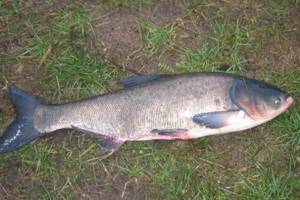
Caught silver carp
Where are silver carp found?
For the most part, silver carp is found in the Amur River basin. Previously, silver carp were found only in lowland rivers of the Republic of China. They became widespread thanks to acclimatization in the Central Asian region and the European territory of Russia, where they were brought in the 60s of the last century from China as a valuable commercial fish. At first they were found mainly in artificial reservoirs or in fenced areas of natural water sources. Then silver carp were settled more widely, which is why fish productivity in the USSR (at that time) doubled.
Kinds
Divided into three types:
- White;
- Motley;
- Hybrid.
All species are valuable from the point of view of commercial fishing. Each type has its own characteristics, both external and behavioral. In the article we will consider each individual, describe the habitats and biological basis of the fish. Let's go in order and start with number one.
Silver carp
A freshwater individual, which is distinguished by the fact that the eyes are below the level of the mouth. For this reason, this species is called "Low-Eyed". It is believed that this is a medium-sized fish, but the body length can reach 1 meter; individuals have been seen even longer. Body weight varies around 15-20 kilograms. Silvery shades predominate, sometimes white, in particular on the belly. The fins are grayish in color. Silver carp lives for more than twenty years.
The main feature of this species is that it is able to jump 3-4 meters out of the water. Stress or fear contribute to this behavior. This happens very often; a noisy boat floats down the river. According to eyewitnesses, sometimes it is enough to swim along the river, hit the water with an oar, and the fish itself will jump into the boat. You just need to be prepared for this, since the size of the silver carp is significant, so you can easily get injured if such a gift falls on your feet or head. Fans of this fish note that it is moderately fatty and very tasty.

Silver carp
Motley
Significantly different from white. Firstly, this is a darker individual, and secondly, the body structure is different, among other things. Bighead carp has a wider and heavier head, the weight of which is 50 percent of the entire body. Dark gray tones predominate. With age, dark spots appear in more mature individuals. By the fins of the fish, you can immediately understand which species the silver carp belongs to, since in the motley carp they are scarlet, crimson in color, with the exception of the tail, which is more brown.
Bighead carp grows faster than white carp. This is due to the fact that he eats better, in the sense that the diet itself is more varied. If the white one consumes mainly phytoplankton, the motley one happily eats various organic particles that are located at the bottom of the bays. The body reaches a length of 1.5 meters and a weight of 45-50 kilograms. Perhaps the diet is responsible for the fact that meat is more tasty than white meat. It also differs in its behavior; it does not jump out of the water column at any noise. On the contrary, it moves as far as possible from potential danger.
Bighead carp
Hybrid
From the name of the species it is clear that this is a hybrid of white and bighead carp. The goal of any crossing of different species is the same, to obtain the best qualities of all species in one. By and large, that’s what happened. He is not as nervous as the white one, the growth rate is like that of the motley one. Tolerates low temperatures, easily, and looks exactly like white.
All silver carp, as noted by researchers, do not want, and cannot, reproduce in a stagnant body of water. The important thing is that it is valuable not so much for its meat, but as an important component in the ecosystem. It is believed that these fish perfectly clean rivers and lakes, due to the fact that they eat particles and substances that pollute rivers. If you have your own pond, preferably with running water, then breed silver carp there and see what the effect is.
In China, this fish is called “Water Goat”. Since it belongs to the Karpov family, its name in English is Silver Carp, which literally translates as Silver Carp.
Perhaps these are the main features of this fish. Large, tasty, and also a health worker for reservoirs!
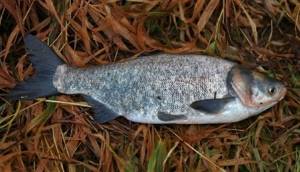
Hybrid silver carp
Features of growing carp and silver carp fingerlings in small ponds
Details Category: Aquaculture on rivers, ponds, lakes, estuaries
The fish farming process is complex and depends on many abiotic and biotic environmental factors. The technology for growing fish for each individual pond may differ; its formation takes place over several years, while the positive elements must be consolidated and not changed in the future. There are, as a rule, several options for solving a particular technological issue: some of them are completely unacceptable, although the result may not be visible at the time the decision is made, others give a satisfactory result, and only one or two of them may be the best. The art of fish farming
- choose exactly one of them. Growing high-quality fish seed material (30 g) is achieved with a final stocking density of a maximum of 30 thousand pieces. carp, 30 thousand pieces. silver carp, and no more than 10 thousand pieces. grass carp per 1 ha [1]. In recent years, there has been a demand for large yearlings weighing 60-100 g, which can reach a weight of 1 kg or more by the fall of the second year of cultivation. To ensure that such a mass of fingerlings is achieved, nursery ponds should be stocked with juveniles grown up to 2 g at a rate of fish productivity (for carp) of up to 0.8-1 t/ha and an autumn yield of about 80% in piece terms (from 12.5 to 20.1 thousand pieces per 1 ha ). Nevertheless, certain points in the technology of growing fingerlings in small ponds stocked with three-day-old larvae, highlighted below, can be useful for beginning fish farmers.
JSC "Rodina" of the Ivnyansky district of the Belgorod region is engaged in the cultivation of marketable fish in the Samarinsky pond with an area of 76 hectares. To provide the farm with its own fish seeding material, in 1996 the wild pond “Steppe Nizhny” with an area of 3 hectares with an average depth of 1.7 m was reconstructed. In 1997, two more ponds were built higher up the ravine, the pond “Sredny” - shallow, partially overgrown with young willow growth, with an area of 2 hectares and a pond “Verkhniy”, with an average depth of 1.2 m, an area of 3.5 hectares.
The ponds are filled with flood waters, so there are no extraneous fish in them. An artesian well with highly mineralized water, located near the upper pond, serves to recharge the ponds in the summer and ensure flow during the wintering of fingerlings in the “Lower” pond. Preparation of small ponds includes filling with water to the maximum level by the beginning of May, introducing fresh manure in piles about 50 cm high along the shore at intervals of 8-10 m to a depth of 30 cm. In places where manure is applied, zooplankton organisms develop in 7-10 days, accessible in size for larvae in the first period after stocking. This method of pond preparation makes it possible to achieve, on average, 30% of the autumn yield of fingerlings in unit terms. Under good weather conditions (water temperature more than 20°C, lack of wind during the stocking period), the autumn yield can increase to 50 percent or more. When working with small ponds, the moment of stocking is of particular importance. Namely, ponds should not be allowed to be overstocked with larvae. In order to be sure of the number of larvae introduced into the pond, it is necessary to count them in one or two bags when stocking (the larvae from the bag are moved using a mill sieve No. 20K into a bucket, the volume of water with the larvae is brought to 10 liters, mixed well, selected larvae into a 100 ml glass and counted). Larvae of carp and herbivorous fish can be transported in bags after they “float,” a visual sign of which is the formation of the first swim bladder chamber. Carp larvae retain high vitality from this point on for no more than 20 hours, during which time they must be introduced into the pond. If the larvae do not receive full-fledged natural food by this time, but are kept in bags or in the hatchery, then irreversible changes in the intestinal tract occur and most of them, being released into the pond alive, nevertheless die. This has implications for planning the timing of loading bags and transporting larvae to ponds. For long-term transportation, it is advisable to use night time. Another important factor in the success of raising fingerlings is the timing of the introduction of carp larvae and herbivorous fish into the pond. The gap in the time of stocking with carp and herbivorous fish should not exceed three days, otherwise the yield in unit terms for silver carp will deteriorate. Carp larvae grow very quickly and switch to feeding on silver carp, so introducing silver carp larvae 10-14 days after the carp [2] is unacceptable. During the growing period, we carried out ten-day observations of the chemical composition of water, the development of phyto- and zooplankton, and also controlled linear and weight growth, Fulton fatness, which is normally 3.00-3.30, and visceral obesity on a five-point scale, the norm of which is in the range of 1.0-2.0 [3]. Results and discussion Stocking was carried out with three-day-old larvae of carp and silver carp (Table 1).
In 1996, with an abnormally high stocking density, the hydrochemical regime of the “Lower” pond is characterized by a stable pH value, low carbon dioxide concentration, and a relatively high content of hydrocarbonates (Table 2). Ammonium nitrogen concentrations were moderately high, with a maximum of 1.48 mg/L in mid-August. Permanganate oxidation and phosphate content in July and August gradually increased from 9.5 to 25.7 mg/l, and from 0.17 to 1.26 mg/l, respectively, this is explained by the high biomass of fish and the amount of their exometabolites in the pond, as well as the intensive development and decomposition of phytoplankton .
From mid-July to the end of August, the fish in the pond experienced oxygen deficiency from 6 to 10 o'clock. At the same time, the fingerlings “swallowed air” over the entire surface of the pond. In the first ten days of August, pre-mortem phenomena were observed around the clock. On these days the fish were not fed, on other days the feeding time was shifted from the morning to the afternoon. At the same time, powdered chalk was intensively added. In August, 700 kg of chalk was added to the pond in 100 kg portions. From July to September, a moderate bloom of microscopic blue-green algae was observed in the pond, which formed the basis of the silver carp’s diet. A high content of zooplankton due to cyclops and rotifers was stated in May 3.7 g/m3 and in early June - 4.9 g/m3 (Table 3). With an increase in the biomass of underyearlings, from the end of June, the content of zooplankton decreased to 0 g/m3.
The underyearlings were fed from the second ten days of June at 180-440 kg per day once. Wheat bran, crushed wheat and barley were used as feed. Control over feed intake was carried out daily by lifting control feeders (low-sided boxes measuring 40x40 cm) from the bottom. Feed costs amounted to 7.8 kg/kg carp growth. By the beginning of July, the length of the carp reached 2.9 cm, weight 1.0 g, fatness according to Fulton was 4.15. By August 14, the length of the carp increased to 6.0 cm, weight - to 9.0 g, fatness was 4.16, this indicates a slow linear growth of fish associated with an unfavorable gas regime, as well as a lack of natural food and, perhaps, excessive artificial feeding. The low weight of fish seed grown in 1996 is explained by the overstocking of the pond and poor absorption of artificial feed for growth, since with a high density of fingerlings in the pond, fish exometabolites have an inhibitory effect on fish [4]. In 1997, during the introduction of carp (May 29) and in the following days, the water temperature dropped to 17°C, there was a strong wind, increased water turbidity was observed, and zooplankton moved away from the shore. As a result, most of the carp larvae died. In the “Upper” pond, which was in operation for the first year, all the larvae died. In the “Middle” and “Lower” ponds, silver carp larvae and a small amount of carp partially survived. It was not possible to repeat stocking at a later date. The chemical composition of water has not changed compared to 1996 data, with the exception of an increase in the concentration of ammonia nitrogen. In this regard, fertilizers were used only once: in July, three tons of slurry were added to each pond. No chalk was used. There were no fatalities in August. Microscopic blue-green algae were present in moderate quantities in all ponds from the middle of the growing season. In the “Upper” and “Middle” ponds, which were exploited for the first time, zooplankton developed only by the end of June, while in the lower pond the concentration of zooplankton was significant already at the beginning of June. The highest content of zooplankton in the pond is due to the absence of fish in it. By the end of June it reached 12.2 g/m3, by mid-July it dropped to 1.7 g/m3, and increased again to 5.5 g/m3 by the end of the month due to strong populations of daphnia and, to a lesser extent, cyclops. In the “Middle” pond, until mid-June the zooplankton content was low - 0.11 g/m3; by the end of June it increased to 18.8 g/m3 due to large daphnia, apparently inaccessible in size for juveniles. By mid-July, the zooplankton content dropped to 0-0.3 g/m3, due to its consumption by fish. In the “Lower” pond in June, the concentration of zooplankton was 9.5-4.1 g/m3 with a predominance of large moins, as well as cyclops, then there was a decrease in the concentration of zooplankton, and at the end of August there was no zooplankton in the pond. There were no fatalities in August. The survival of the larvae in the “Middle” pond may have been associated with its high overgrowth, that is, with the presence of shelters for fish under unfavorable stocking conditions. In July, a silver carp measuring 6.6 cm and weighing 10.0 g was caught in the “Middle” pond. Subsequent control catches did not yield results. Regular feeding of the fingerlings was not carried out, since with a daily dose of about 200 kg of feed given to the “Middle” and “Lower” ponds, food from the control feeders was not eaten. The catch of silver carp from the “Middle” and “Lower” ponds amounted to 2.1 tons weighing 30 g. In 1998, the chemical composition of the water was characterized by an increased content of bicarbonates, a maximum concentration of ammonia nitrogen, as well as phosphates - due to intensive fertilization carried out in accordance with the results of water analyzes . In mid-May, 8, 7 and 7 tons of manure were added to the “Upper”, “Sredny” and “Nizhny” ponds. In July, three tons of slurry and 80 kg of UAN-24 (a complex ammonia mixture with a nitrogen content of 24%) were added to each pond. In the third ten days of August, 100 kg of UAN-24 were added to the “Upper” and “Sredny” ponds, the “Nizhny” pond was not fertilized, and no death phenomena were observed this year. Massive development of microscopic algae in the “Middle” ponds since mid-August; phytoplankton has not developed in the “Lower” pond. Despite intensive fertilization and high levels of ammonia nitrogen and phosphates, zooplankton was completely absent in the “Upper” and “Lower” ponds. The average seasonal content of zooplankton in the “Middle” pond was 0.28 g/m3. However, the nutrients in the “Lower” pond were apparently absorbed by microorganisms of the pond community. The weight of fingerlings raised in the “Upper” and “Middle” ponds exceeded 20 g. The worst results for rearing fingerlings (6.6 g) were obtained in the “Lower” pond. This is due to overstocking, which arose as a result of good survival of juveniles. At the same time, the average seasonal fatness index of carp was high - 5.02, which indicated slow linear growth. In July, in the “Nizhny” pond, a group of large fish emerged from the carp composition, which by autumn reached a mass of 12.5 g, but their share in the total carp mass was insignificant. The carp were fed with wheat bran - 6.9%, as well as crushed grain of rye - 88.5% and barley - 4.2%. Feed costs amounted to 4.6 kg/kg carp growth. The diet of silver carp was based on bottom food. The lack of phytoplankton apparently slowed the growth of silver carp. The autumn catch amounted to 4 tons of carp, with an average weight of 25 g, and 3 tons of silver carp, weighing 20 g. In 1999, the collective farm fish farmers worked independently; we carried out only one survey of the Steppe ponds - in early July. The content of ammonia nitrogen in all ponds was low - 0.51-0.77 mg/l with a norm of 1.0, up to 2.0 mg/l [5], the concentration of phosphates was at an average level - 0.130.33 mg/l. The highest concentrations of nutrients belonged to the “Lower” pond. The results of water tests indicate that the ponds need nitrogen fertilizers. The phytoplankton of the “Upper” and “Middle” ponds is represented by a moderate amount of microscopic blue-green algae. In the “Lower” pond, only green algae of the genus Volvox were found - indicators of the oligosaprobic zone [6]. The concentration of zooplankton in the “Upper” pond was 3.5 g/m3 due to rotifers of the genus Asplanchna, in the “Middle” pond it was 1.5 g/m3 due to Cyclops, and in the “Lower” pond it was only 0.6 g/m3. Data from chemical and hydrobiological analyzes allow us to conclude that the minimum number of fish is in the upper pond, and the largest number is in the lower pond. The growth rates of carp fingerlings by the beginning of July in the upper, middle and lower ponds were: length - 7.6, 4.4 and 4.7 cm; weight - 26.9, 4.8 and 6.8 g; body condition 6.05, 5.63 and 6.65, respectively. The average visceral obesity of carp from the upper pond reached 1.3, and from the lower pond - 0 points. In the intestines of carp there is mainly detritus. Abnormally high values of the fatness coefficient at a low level of feeding are explained by a stop in linear growth. It is recommended to increase the daily feeding dose in ponds to 150, then to 200 and 250 kg of wheat bran per day under control of palatability. The catch in the fall was 3 tons of carp and 3 tons of silver carp. The catch was dominated by fingerlings with an average weight of 25 g. In 2000, stocking with carp larvae was carried out at the end of May, and with silver carp larvae - in mid-June. There was a gap of about two weeks in the timing of stocking. At the end of June, a carp measuring about 3 cm and a lot of small silver carp larvae were found in the “Middle” pond. In the lower pond, carp measuring 1.8 cm and silver carp larvae were caught, but in smaller quantities than average. During the autumn fishing, silver carp was not found because it was eaten by carp. The chemical composition of the water is characterized by a low content of ammonia nitrogen. Intensive fertilization of the ponds was not carried out due to certain technical difficulties. The phosphate concentration varied from 0.11 to 0.55 mg/l, with a tendency to increase towards the end of the season. From June until the end of the season, moderate blooms of microscopic algae were observed in the ponds. In the absence of silver carp in the ponds, the zooplankton content was high and decreased only by mid-August. The average weight of carp in the “Upper” pond reached 6.6 by the end of July, by the beginning of August - 15.8, by the middle of the month - 17.2 g, fatness - 3.31, 3.81, and 3.83, respectively. Intestinal obesity in August was 0.5-0.6 points. The growth retardation in August was associated with the intense oxygen regime. In the “Medium” pond, the water level was low throughout the season, which negatively affected the growth of carp fingerlings. By the end of August, the length of the carp reached 6.9 cm, weight 10.6 g, fatness was 3.26, obesity - 0.6 points. The low growth rate is explained by insufficient feeding and oxygen deficiency in August. This year, the “Lower” pond was closed late, and the water level was 1.5 m lower than usual. With a small depth and volume of the pond at the beginning of the season, the hydrochemical composition (decrease in pH, carbon dioxide, calcium, bicarbonates, ammonium nitrogen, increase in phosphates) is influenced by destructive processes occurring in the muddy soil. With this chemical composition of water, neither phytoplankton nor zooplankton developed, with the exception of Volvox. By August, with the accumulation of organic substances from fish excretions without the use of fertilizers in the ponds, the pH normalized, the carbon dioxide content increased, the massive development of blue-green algae began, and the concentration of zooplankton increased from 0.25 to 1.4 g/m3 in early August, due to Cyclops, Diaptomus, Moina and rotifers, and up to 1.9 g/m3 by mid-August - due to moinae, brachionus, cyclops and other listed organisms. Since the beginning of August, the oxygen content in the “Lower” pond has decreased, and the living conditions of the fish have worsened. With all the unfavorable changes in the habitat of fish in the “Lower” pond described above, by mid-August the length of the carp increased to 7.9 cm, weight to 15.0 g, body condition was 3.00, and visceral fatness was 0.6 points. In addition to these fish, the pond was inhabited by a small group of leaders, large carp, which by mid-August had reached a length of 10.8 cm, a weight of 38.8 g with a fatness coefficient of 3.79 and visceral fatness of 1.2 points. These fish feed first until satiation due to the “dominance effect” in feeding [7]. In August, all carp from the “Lower” pond were found to have a moderate degree of ichthyophthyriosis infestation, and some fish showed signs of a latent stage of aeromonosis development. After therapeutic treatment of the pond with bleach at a dose of 1 g/m3, the signs of disease disappeared and there was no death of fish. Crushed wheat grain predominated in the composition of carp feed. From July to September, 16.7 tons of feed were added to the pond. Feed costs for carp amounted to 4.3 kg/kg growth. As a result of the autumn fishing, we obtained carp production in the amount of 3.9 tons, most of which reached a weight of 19 g. Silver carp were absent. Conclusions 1. When raising fingerlings in small ponds, you should follow the rules for their preparation for stocking, transportation and the principle of simultaneous introduction of carp and silver carp in an amount of 20 thousand each. per 1 hectare of pond area. 2. Regular observations of the chemical composition of water and the development of phyto- and zooplankton and growth indicators (length, weight, fatness, fatty viscera) allow for prompt adjustment of the daily dose of feed, fertilization of ponds (slurry, nitrogen, phosphorus and calcium mineral fertilizers), therapeutic measures, as well as judge the number of fish in ponds. 3. In the absence of silver carp, abundant development of zooplankton is achieved with a reduced level of nitrogen and phosphates in the water, and fingerling carp make good use of artificial feed for growth: crushed wheat, rye, barley and wheat bran.
References 1. Gerasimova T.D., Volkova S.I. Ecological and physiological basis of adaptation of carp (Cyprinus parpio L.) at a high level of intensification // Biological foundations of fish farming: Current problems of ecological physiology and biochemistry of fish. - M.: Nauka, 1985. -S. 167-178. 2. Efimova E.N., Chertikhin V.G. Biotechnology for the production of fish seeding material in ponds // Collection of works of the All-Russian Scientific Research Institute of Pond Fisheries. - 1982. - No. 35. - P. 117-143. 3. Volynkin Yu.L. Laboratory control system for growing fish // International scientific and technical conference dedicated to the 70th anniversary of the founding of the Kaliningrad State Technical University: Materials, part 1. - Kaliningrad, 2000. -S. 124-125. 4. Volkova S.I. Some morphophysiological parameters of the blood of carp underyearlings in ponds with different levels of intensification // Intensification of pond fish farming: Collection of scientific papers of the TSHA. - M. - 1982. - P. 53-56. 5. Collection of regulatory and technological documentation for commercial fish farming. -M.: Agropromizdat, 1986. - T.2. — 317 p. 6. Yashnov V.A. Workshop on hydrobiology. - M.: Higher School, 1969. - 427 p. 7. Volynkin Yu.L., Strakatov P.A., Pallady A.L., Vasiliev S.P., Kozlov A.G. About feed and methods of feeding commercial carp // Fisheries. - 2007. - No. 4. - P. 90-93. FEATURES OF CULTIVATION ONE JEARLING CARP AND THE SILVER CARP IN LITTLE PONDS JL Volynkin 1, OB Volynkina 2 1 Belgorod State University Pobedy St., 85, Belgorod, 308015, Russia E-mail: This email address is being protected from spambots. You must have JavaScript enabled to view it. 2 Open Company “Ichtiobiopharm” Magistralnyi line, 6, Belgorod, 308036, Russia The article deals with the processing methods of preparation of the ponds and their installation by larvae of fish and features of transportation of larvae. The importance of terms combination of installation in a pond of carp and silver carp fishesis marked. Data on a chemical compound of water, hydrobiology and results of cultivation of one pearling a carp are cited some years, importance of these monitoring supervision for application of means of an intensification of fish-breeding process and creation of comfortable conditions of housing for fishes is underlined . Keywords: carp, silver carp, one earling, phytoplankton, zooplankton, fertilizer, feeding, growth, ichthyophthyriosis.
Yu.L. Volynkin 1, O.B. Volynkina 2 1 Belgorod State University Russia, 308015, Belgorod, st. Pobeda, 85 E-mail: This email address is being protected from spambots. You must have JavaScript enabled to view it. 2 Ichthyobiopharm LLC. Russia, 308036, Belgorod, Magistralny lane, 6
